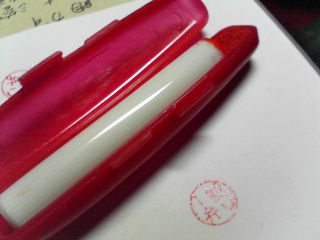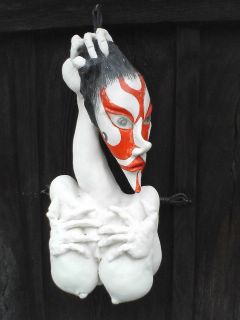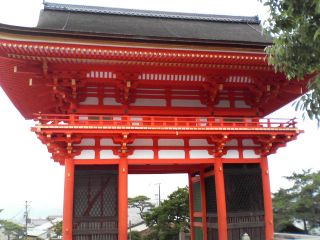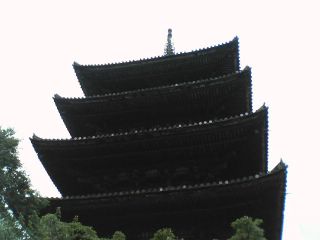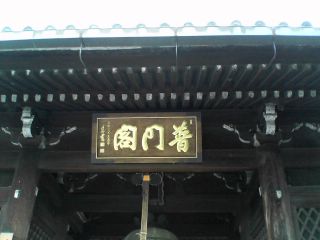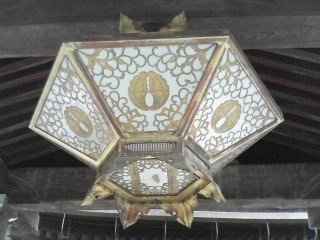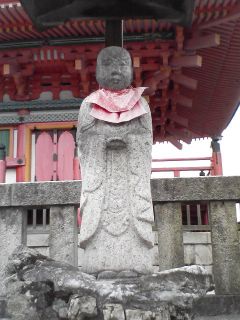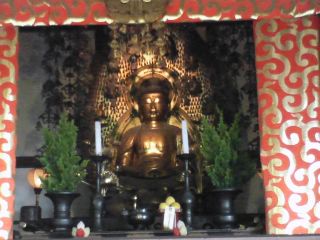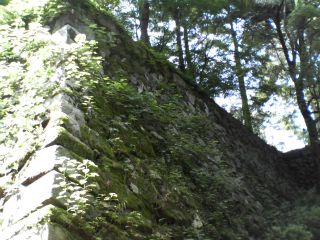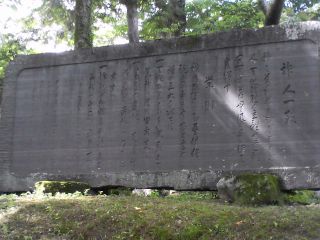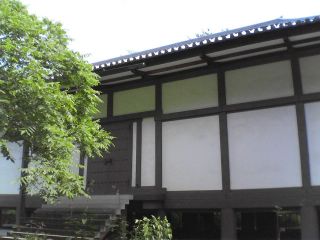Today was a day of firsts.
I began the day with a trip to the Mitsubishi Bank (Japan’s largest bank chain) to set up an account for the salary I will receive from my summer internship. While the term is thrown around a lot, I am proud to say that I now have a genuine “off shore” account in which to deposit all of my laundered money.
In order to set up a Japanese bank account, we all needed what are called “hanko” or name stamps (the Stanford Center had these made for us). These small oblong plastic stamps are officially registered with the government and act as a legally binding signature for things such as bank accounts, mail delivery, and company business transactions. They sell fake hanko in department stores for a few hundred yen, but I could never find any that resembled my name. I guess there aren’t too many Bentaros or Benichiros running around Japan. The one I have now however is official, registered, and has my name on it in Japanese.
On a related note, Japanese ATM machines rival Stephen Hawking in IQ. These machines let you deposit any combination of coins and bills into your account, act as a Coin Star machine – converting any unwanted change into “folding money,” and even automatically balance your checkbook. This last one is not a joke. You simply hit the “update my checkbook” button, and a little door opens which sucks in your checkbook. After 10 seconds, the machine spits it out and, low and behold, the register page now has an up-to-date printed log. When people talk about Japan as the most technologically advanced society on the face of the planet, this is the type of innovations they are talking about.
Later in the day, I continued with another first - visiting Kiyomizu Temple (清水寺). Due to its high elevation and picturesque balcony that overlooks the surrounding forestland; Kiyomizu is the most famous temple in Kyoto. The name literally means “pure water” in Japanese. Kiyomizu is said to have drinkable water with healing properties. Since Kiyomizu-Dera is a HUGE tourist attraction, the small shop-lined streets leading up to the temple grounds were packed with gaijin tourists. There was a neat little shop that sold some really weird, ghoulish looking artwork pieces that I thought were very neat (if not a little bit frightening).
Kiyomizu Temple worships the monk turned Bodhisattva Jizo. Jizo is thought to be the merciful and compassionate side of a powerful god - The nasty and unforgiving side is named Kanon. Jizo is usually represented as an old bald monk-looking man with large geta sandals. Jizo (under different names) comes from Indian and later Chinese Buddhism. Only in Japanese Buddhism however, is Jizo believed to be the savior of children.
After my trip to the temple, Kevin and I met up later to go to dinner. Here was another first – eating Oden. Oden is a traditional wintertime food in Japan. It is a mishmash of tofu, fishcake, lotus root, daikon radish, and other cheap foods cooked overnight in a sweet broth. It reminded me of a Japanese style stew almost. The flavor was very yummy, but it was heavily overpriced given the amount of food you got. When I was in Akihabara in Tokyo before my overseas program started, I remember seeing oden being sold in a can with a cute female manga character featured on the front. I asked an anti-social Japanese kid once what it was and he practically jumped through the store window to get away from me.
On the way home after dinner - another first! I, and every other passerby, came across an ojisan (elderly gentlemen) passed out due to too much sake intake. This man who looked to be in his late 50s / early 60s was lying spread-eagle in the middle of the sidewalk on the busiest street in downtown Kyoto. He had obviously drunk too much and was sleeping peacefully. He had taken off his shoes, rolled up his jacket and placed it under his head, and stretched out his arms and legs to make a giant X with his body, as if to take up the maximum amount of space possible on the busy downtown sidewalk.
An old Japanese saying goes “Deru kugi wa utareru” or, “the nail that protrudes gets hammered down.” I can’t think of anything that better describes this, the Japanese peoples’ general preference for “not standing out” in group situations than the following image. One-by-one, tens and tens of Japanese people of all ages, shapes and sizes, carefully played a game of hopscotch, skipping and stepping in between the sprawled out limbs of the sidewalk man, as if nothing was out of the ordinary. As I did the same, pushed forward by the mass of people to my rear, I looked back to see couples still holding hands and cell phone conversations not missing a beat as people stepped right over the unconscious man.
As I crossed the Kamo River, I saw an ambulance speed by and police officers march past me. I guess somebody must have done the right thing.
B.E.W.
"We are fools whether we dance or not, so we might as well dance." - Japanese Proverb
Friday, June 30, 2006

A closeup of the name stamp itself. 鯨 means "whale" in Japanese, リー represents the "ey" sound at the end of my last name, and 弁 is simply "Ben." Put it all together and you get Ben Whaley (sort of)! There are lots of different kanji for "Ben" in Japanese. I chose the kanji that means eloquence or flower petal, depending on how it's used. It is also used in "Bento" or the Japanese word for boxed lunch. There is a different Ben kanji that is used in the word "Benjoh" which means toilet. Whenever I told a Japanese person that I was having a hanko made, they always laughed and told me not to pick the kanji for my name that meant toilet.

I took a picture of this because I thought it was somebody's personal prayer tied to one of the large trees that surround the elevated Kiyomizu-Dera. There is a festival in Japan called Tanabata, where people do this practice and then the trees are floated down the river. However, this is actually a sign that asks patrons NOT to tie any sorts of fortune or prayer slips to the trees.
Wednesday, June 28, 2006
Nine Days and Counting
Only nine days left in Kyoto until I make the big move to single life in Tokyo - this could be dangerous!
In the meantime, I have plenty of tests and reports to keep me busy until the term ends.
B.E.W.
In the meantime, I have plenty of tests and reports to keep me busy until the term ends.
B.E.W.
Tuesday, June 27, 2006
Shimogamo Shrine (下鴨神社)
I met up with my friend Aiko from Kyoto University this afternoon and the two of us went to Shimogamo Shrine in downtown Kyoto. Since it was super hot and humid today, she made a good choice by selecting a place that was situated smack dab in the middle of a small forest - we took full advantage of the cool breeze.
Shimogamo Shrine was nice, albeit not too different from the dozens of other Japanese shrines and temples I have visited during my stay in Kyoto. There was a small replica of an old Japanese wooden house. That's about all I can tell you, because that is all Aiko chose to translate for me off the incomprehensible sign's kanji characters.
Also, there are lots of birds in the Shimogamo area, from sparrows to ducks to crows to herons. There also is evidently some linkage between a Japanese soccer team perhaps named the crows (?) and a wooden sign at the shrine we visited that had the word "crow" written on it. Again, I would tell you more, but that is the extent of the information that Aiko passed on to me.
Enjoy the pictures below!
B.E.W.
Shimogamo Shrine was nice, albeit not too different from the dozens of other Japanese shrines and temples I have visited during my stay in Kyoto. There was a small replica of an old Japanese wooden house. That's about all I can tell you, because that is all Aiko chose to translate for me off the incomprehensible sign's kanji characters.
Also, there are lots of birds in the Shimogamo area, from sparrows to ducks to crows to herons. There also is evidently some linkage between a Japanese soccer team perhaps named the crows (?) and a wooden sign at the shrine we visited that had the word "crow" written on it. Again, I would tell you more, but that is the extent of the information that Aiko passed on to me.
Enjoy the pictures below!
B.E.W.
Monday, June 26, 2006
Oomoto (おほもと教)
For two years now I have had the privilege of performing on stage with the wonderfully supportive, talented, and hilarious group of students who make up the Stanford Improvisors (known as the SImps). These students are not just my artistic partners when it comes to improvised theater; they are my close friends and people I deeply trust. You can visit our website at simps.stanford.edu - there are lots of funny movie trailer-style promo videos from our past shows up on the site that you can view to get a flavor for the group.
I have also had the privilege throughout my academic career to learn from truly insightful, brilliant, and inspiring teachers. One such teacher and mentor is Patricia Ryan Madson, a former near thirty year faculty member of the Stanford Drama Department, and the original founder of our group the SImps. Patricia has written a truly wonderful book entitled, “Improv Wisdom: Don’t Prepare, Just Show Up.” Patricia loves traditional Japanese art and culture more than I do, and is very knowledgeable about it, having spent extensive time in the country. Many principles she learned from her time in Japan and from Eastern philosophy make their way into her book, alongside her truly unique view of how the art of improvising can lead to a healthy and happy life. You owe it to yourself to check out her book! Please visit her website www.improvwisdom.com for more information.
Patricia has been connected with one of Japan's new religions, Oomoto, literally “the origin” in Japanese, since 1980 and she served as my door into the organization for a term paper I was writing. Oomoto is a sect of Shinto and finds its origins with Nao Deguchi, a poor illiterate Japanese woman who was said to have been possessed by the spirit of God in 1892 and prompted by the spirit to lead mankind in an effort to reinstate the Kingdom of Heaven on earth. The illiterate Nao wrote over two thousand pages of Hiragana calligraphic scripture while possessed by the spirit of God. These writings, along with “Tales from the Spirit World,” written by the co-founder of Oomoto, Onisaburo Deguchi, make up the spiritual canon of Oomoto.
Among its unique features, Oomoto believes that traditional Japanese art such as pottery, Noh theater, the tea ceremony, and calligraphy is the “mother of religion,” and that by practicing such art forms, one cleanses the body and mind and becomes closer to God. Every Spiritual Leader of Oomoto has engaged in some sort of traditional Japanese art form. You can see examples of Nao’s original holy calligraphic writings and Onisaburo’s pottery and paintings down below.
Oomoto is also unique in that its co-founder Onisaburo Deguchi adopted Esperanto as one of the religion’s official languages, because he believed it to be the universal language with which the world’s religions could communicate with each other. Since its creation, Oomoto has been concerned with uniting the world’s religion under a belief in the same one-true God, and ending war and hatred. Oomoto strives for peace and prosperity for all the people of the world, and is active in the global humanitarian effort as well as many world religious forums.
There are currently over 150 thousand Oomoto followers. Most are in Japan, though there is also a large contingent in Sao Paulo, Brazil. As proscribed by the holy scripture, the Spiritual Leaders of Oomoto must be female descendants of Nao Deguchi.
I visited Oomoto’s educational center in Kameoka, Japan – the birthplace of co-founder Onisaburo Deguchi (about a half hour from Kyoto by train) - and met with Tanaka-san, the director of Oomoto’s International Department. He walked me around the Oomoto grounds, situated in the forestland amongst the ruins of the old Kameoka Castle. There is one large shrine with an altar and Noh stage in it. There is also a traditional tea house, botanical garden, dormitories, and classrooms, as well as tons of protected forestland. Oomoto’s premiere shrine and spiritual center is located about one hour away from Kameoka in the city of Ayabe (the hometown of Nao Deguchi).
I cannot possibly condense all that I have recently learned about Oomoto into this short blog post. It is a truly unique and fascinating religion, no matter which lens you look at it through. If you have an interest in religious studies, or traditional Japanese art and culture, I highly recommend that you check out their website. For more information on Oomoto, please visit www.oomoto.or.jp
Please enjoy the pictures below from my trip to the Oomoto grounds in Kameoka, Japan.
B.E.W.
I have also had the privilege throughout my academic career to learn from truly insightful, brilliant, and inspiring teachers. One such teacher and mentor is Patricia Ryan Madson, a former near thirty year faculty member of the Stanford Drama Department, and the original founder of our group the SImps. Patricia has written a truly wonderful book entitled, “Improv Wisdom: Don’t Prepare, Just Show Up.” Patricia loves traditional Japanese art and culture more than I do, and is very knowledgeable about it, having spent extensive time in the country. Many principles she learned from her time in Japan and from Eastern philosophy make their way into her book, alongside her truly unique view of how the art of improvising can lead to a healthy and happy life. You owe it to yourself to check out her book! Please visit her website www.improvwisdom.com for more information.
Patricia has been connected with one of Japan's new religions, Oomoto, literally “the origin” in Japanese, since 1980 and she served as my door into the organization for a term paper I was writing. Oomoto is a sect of Shinto and finds its origins with Nao Deguchi, a poor illiterate Japanese woman who was said to have been possessed by the spirit of God in 1892 and prompted by the spirit to lead mankind in an effort to reinstate the Kingdom of Heaven on earth. The illiterate Nao wrote over two thousand pages of Hiragana calligraphic scripture while possessed by the spirit of God. These writings, along with “Tales from the Spirit World,” written by the co-founder of Oomoto, Onisaburo Deguchi, make up the spiritual canon of Oomoto.
Among its unique features, Oomoto believes that traditional Japanese art such as pottery, Noh theater, the tea ceremony, and calligraphy is the “mother of religion,” and that by practicing such art forms, one cleanses the body and mind and becomes closer to God. Every Spiritual Leader of Oomoto has engaged in some sort of traditional Japanese art form. You can see examples of Nao’s original holy calligraphic writings and Onisaburo’s pottery and paintings down below.
Oomoto is also unique in that its co-founder Onisaburo Deguchi adopted Esperanto as one of the religion’s official languages, because he believed it to be the universal language with which the world’s religions could communicate with each other. Since its creation, Oomoto has been concerned with uniting the world’s religion under a belief in the same one-true God, and ending war and hatred. Oomoto strives for peace and prosperity for all the people of the world, and is active in the global humanitarian effort as well as many world religious forums.
There are currently over 150 thousand Oomoto followers. Most are in Japan, though there is also a large contingent in Sao Paulo, Brazil. As proscribed by the holy scripture, the Spiritual Leaders of Oomoto must be female descendants of Nao Deguchi.
I visited Oomoto’s educational center in Kameoka, Japan – the birthplace of co-founder Onisaburo Deguchi (about a half hour from Kyoto by train) - and met with Tanaka-san, the director of Oomoto’s International Department. He walked me around the Oomoto grounds, situated in the forestland amongst the ruins of the old Kameoka Castle. There is one large shrine with an altar and Noh stage in it. There is also a traditional tea house, botanical garden, dormitories, and classrooms, as well as tons of protected forestland. Oomoto’s premiere shrine and spiritual center is located about one hour away from Kameoka in the city of Ayabe (the hometown of Nao Deguchi).
I cannot possibly condense all that I have recently learned about Oomoto into this short blog post. It is a truly unique and fascinating religion, no matter which lens you look at it through. If you have an interest in religious studies, or traditional Japanese art and culture, I highly recommend that you check out their website. For more information on Oomoto, please visit www.oomoto.or.jp
Please enjoy the pictures below from my trip to the Oomoto grounds in Kameoka, Japan.
B.E.W.
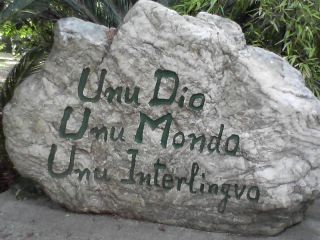
Here is a rock with the phrase, "One God, One World, One International Language" engraved in Esperanto. Esperanto was chosen as the official language of Oomoto by Onisaburo Deguchi, because he believed it to be the universal language with which all the world's religions could communicate with each other.

This is a sample of Nao Deguchi's original Ofudesaki or "From the tip of the brush" spiritual writings. Written entirely in Hiragana, the illiterate Nao Deguchi was possessed by the spirit of God and wrote over two hundred thousand pages of text like what you see in the picture. This would become the basis of Oomoto's holy writings.
Saturday, June 24, 2006
A White Boy in China (中国での白人)
中 VS. 日
Forget Godzilla VS. King Kong, Batman VS. Superman, Speedy Gonzales VS. The Roadrunner, or My Dad VS. Your Dad…Finally, the face-off of the century, the battle to end all battles, a bilateral bombastic bout – only one country can emerge victorious…Who will it be? - CHINA VERSUS JAPAN!!! Let’s GET IN ON!!!
-------------------------------------------------------
Pollution & Grime:
A fun fact for your next dinner party is that of the world’s ten most polluted cities, seven of them are located in China. As an asthmatic, I only assumed that I would collapse dead of an attack the minute I got of the plane in Beijing. To be fair, this category is really a non-competition. I have not visited another society where people hand pickup litter and wash the streets every morning as they do in Japan. Japan also leads the world in smart energy consumption and environmentally conscious manufacturing. While Beijing was certainly dirtier than Kyoto, it did not seem any worse off than large American cities such as DC or L.A. The only place where I truly felt the pollution in Beijing was Tiananmen Square. Here, upon exiting the cab, you were enveloped in dreamlike a white smog. This smog is the reason why there are no pictures from Tiananmen Square on my blog. After a while, my eyes started to sting. My friends and I took refuge in an underground passageway. As we were ascending from the underground passage, there was a point where we were still halfway below ground but couldn’t see any of your surroundings above ground. This precise moment felt like you were enclosed in a sensory deprivation chamber of smog.
WINNER: China
Crowds:
As with pollution, I had the preconception that I would become entangled in a wild flailing mass of fleshy limbs if I dared walk the Beijing streets. This proved not to be the case. While China is currently the most populous country in the world with over 1.3 billion people, it sure doesn’t feel like it. Beijing felt like an airport in the early morning. The key to China’s spacious feel is an abundance of land. You don’t feel nearly as packed and cramped in China. The streets are wide, and you can get to where you want to go easily by foot (if you’re not killed by a “street killer” that is). In addition, where Japan has used virtually every ounce of its inhabitable space (there is still a fair amount of mountainside space available however, but Japanese laws prevent it from being developed), China has just begun its modern metropolitan development. I spotted Beijing city busses that were as crowded as the ones I ride in Kyoto. Also, The Great Wall was jammed packed with people, but that’s to be expected from the nation’s premiere tourist attraction.
WINNER: Japan
Prostitution:
One on night I ventured one block from our hotel to a shop that sold pirated DVDs. During this one block walk, I was approached by six different prostitutes. They would come up to me and say, “I’ll come up to your room” or “I’ll give you a massage big boy.” These ladies, many of which stood right outside my hotel, started screaming prices at me as I walked. It seems like I could have gotten laid for as little as $20. Japan has its fair share of “soap shops” and escort services as well if you know where to look. It only takes a stroll down a certain street in downtown Kyoto to see Japanese pimps at work. Unlike the American variety, Japanese pimps where black suits and earpieces as opposed to fuzzy hats and bling. Occasionally they will hand you a slip of paper and say “Hey, where you from?” Chinese pimps and prostitutes have a much better command of the English language which is better for business.
WINNER: China
Food:
My classmates gobbled up the meat buns, shumai, and other assorted Chinese dishes with huge smiles on their faces while I longed for sashimi and tempura. Chinese food in Beijing was dirt cheap – for instance, 10 meat buns would run you about a dollar, set meals at McDonald’s or Kentucky Fried Chicken were two dollars, and you could eat with your friends at a sit down restaurant and not spend more than five dollars each. This is compared to Japan where, unless you eat every meal at the convenience store, you can easily spend $20-30 for a small plate of sushi. The key difference however is that the quality range of the Chinese food you will get for $2 is huge. While in Beijing, my friends and I ate in a dumpling restaurant chain (there are stores throughout Asia and in North America as well) that was billed as one of the top ten restaurants in the world. While this accolade was an overstatement, the soup filled pork dumplings that gushed like geysers when you bit into them were delicious. We also went to the most famous Beijing Peking Duck restaurant and the gourmet food there was also wonderful. However, I also ate at sit down restaurants with friends where the cold congealed chicken and grisly chunks of darkened meat were uneatable. Also marring my Chinese food experience was the fact that nine times out of ten I got severe stomach pain several hours after eating anything in China. I still have lingering stomach pain as I write this blog entry.
WINNER: Japan (though I am biased, food is a personal preference)
Weather:
The weather in China was usually scorching hot: 95 – 105 degrees to be exact. It poured buckets of rain with thunder and lightening while we were in Beijing. Currently in Japan it is “tsuyu” or the rainy season, so I see much of the same in the land of the rising sun. It is currently hovers around 80 – 90 degrees everyday with a high level of humidity.
WINNER: Tie
Shopping:
You come to China to shop. From videogames, to electronics, designer fashion, to human organs, you can find just about anything you want in China (and chances are it is all fake). It is a general rule that you can haggle for anything in China – though if you try to go into the real boutiques and do so, they will ask you to leave. It is also a rule that everyone has something to sell you – from the innocent looking lady on the corner who is ready to shove a “genuine” leather wallet under your nose for a whiff, to the little kid who really wants to sell you the half-melted pond water popsicle he cooked up this morning, everyone is a salesman. Vendors in China are aggressive! Especially if you look fat, jolly, and white as I do, you will get physically assaulted by these vendors. Some women will put their arm around you and touch your stomach to get a sale– I call these ones the “lovers.” Others grab onto your wrist and pull you with all their might over to the booth – I call these ones the “fighters.” Others still will follow you for blocks, shoving fake DVDs in your face or opening and closing a shoddy briefcase filled with Folex Watches – I call these ones the “shadows.” All the vendors have a superior command of English than just about any Japanese salesperson I have ever met. This is because in China, they really want your money. Vendor’s utterances include:
“Hey sir, hey sir, come over here and take a look sir”
“I make you best deal my friend. Sir...PLEASE!”
“You show me final price, we end this now”
“What, you think I’m stupid? I go out of business!”
WINNER: China (you can’t shop this well anywhere else!)
Regular People:
Not being able to speak Chinese, I can’t really judge the character of the people I encountered. I will say however that I found most people (as long as they weren’t beggars, prostitutes, or salesmen) to be very nice and helpful, considering the fact that I was a foreigner who knew absolutely nothing. Staff members and restaurant employees I encountered were all very gracious hosts. The Beijing University students I met also seemed very bright and outgoing. While I disagreed with their adamant and vocal support of the Communist Party, they were very outspoken nonetheless. While many, myself included, would say that Japanese people wrote the book on being overly polite and accommodating, the Chinese people I met were no slouches by any means. In a sense, it was refreshing that, compared to the often silent and shy Japanese, Chinese people served as the exact opposite in personality– loud, abrasive, and direct.
WINNER: I can’t judge – ask me when I can speak Chinese and actually connect with people.
Atmosphere:
When you walk near any official government buildings or tourist attractions, you immediately see armed guards. The People’s Liberation Army marches down the street chanting each night. For sure, the overall atmosphere in China was very different from that in Japan. I never felt particularly unsafe in China, rather, there was always the sinking feeling that because I was a white tourist, everyone was trying to take me for a ride. In Japan you don’t have to check for your wallet every block, nor do you worry that your cab driver will lock the doors and refuse to let you out unless you pay him “60 American dollars.” These types of things mar the Chinese atmosphere in my opinion.
WINNER: Japan
Beer:
Tsingtao is a good beer - it is crisp and tastes a lot like Corona. I’m sure there are other varieties of delicious Chinese beer as well, but I didn’t get a chance to sample them. For sheer variety (and by this I mean three types – four if you count Suntory), I have to give this to Japan.
WINNER: Japan (please refer to my post “Kanpai” for more about Japanese drinking culture)
Money:
I pulled out an American $10 bill the other day and marveled at how small it looked. I had been staring at the novelty sized Japanese bills (nearly a quarter sheet of paper in size) for so long. Chinese bills are just as big as Japanese ones. Unlike Japanese bills, which feature different intellectuals, Chinese money all features the same picture of Chairman Mao in different colors (I think you can make a rainbow if you collect them all). I love currency systems that utilize high denomination coins such as Japan and Canada. Whenever I pop a 500 Yen ($5) coin into a vending machine, it feels like I’m spending no money at all. Because Chinese goods are cheap, you often need a stack of Chinese money to buy something. This is especially true for really cheap food below 10 Kwai (the exchange rate was 8 Kwai to the Dollar). Since the Chinese currency system doesn’t really utilize coins, you have to pay in one Kwai bills that aren’t worth the paper they’re printed on.
WINNER: Japan
People in Need of Help:
Homelessness is a rising problem in Japan. Nowadays you see homeless people sleeping in the major train stations. Osaka Park has one of the largest concentrations of homeless people in all of Japan. Even Kyoto’s own Kamo River features makeshift box houses with blue tarps over them underneath each major bridge. All this said however, there is still no comparison with China. When you arrive at the Beijing International Airport and take a taxi ride to your Landmark Hotel past the new buildings being constructed for the 2008 Summer Olympics, you find yourself thinking of the phrase “developing nation” with disbelief. I had a similar feeling when I visited the resort areas in southern Mexico. However, with only a short 10-minute cab ride out of the city, you come face to face with extreme poverty.
Even without seeing the collapsing public housing and dirt streets as I did, you always feel poverty’s presence. Beggars roam the Beijing streets – they are crying children, people with pets, the elderly, and cripples. Especially if you are white, they approach you, hit their cup against your thigh and (in the case of children) begin to cry, or (in the case of adults) repeat the word “money” over and over again. When you are told that impoverished Chinese families can live on the equivalent of one dollar a day, you find yourself wanting to help everyone who asks for money – but this is impossible.
The theme of our academic conference was, “China and its Role in the 21st Century.” There is a lot of talk recently (especially in America) about China as the new Japan, thanks to the country’s recent astonishing economic growth rate (though nowhere near Japan’s level in the post war era). According to TIME Magazine, perhaps we should all learn Chinese and stock up on red-colored clothing. This is a misnomer. Japan is the second largest economy in the world behind the United States. Chinese GDP is growing rapidly – true – however, per capita GDP is still drastically low when compared to the world standards of the U.S. and Japan. While the Chinese government continues to funnel money into manufacturing and R&D, the problem remains that the overwhelming majority of Chinese people live in extreme poverty and have no quality of life. Add this to human rights violations and problems with pollution and the environment and it becomes clear that China has a long way to go. This is not to say that China is not making significant progress as a developing nation – it is – but, I don’t believe we will see a China on par with the United States and Japan in my lifetime unless significant advancements are made for the Chinese people – the ones who really matter.
WINNER: China
Scary Transportation:
“Street killers,” as our Great Wall tour guide told us jokingly, are anyone with a driver’s license in China. One of my Stanford friends kept telling me that every time you make a U-turn in a Beijing taxicab, you have a fifty percent chance of getting hit. It is a very interesting feeling to put your life in someone else’s hands. I lost count of how many times I should have died while riding in Chinese public transportation. I experienced everything from cab drivers smoking and spitting in the car, to drivers stopping and leaving their vehicles - refusing to drive any farther. One cab driver started screaming and fighting with another guy, while, on another trip, the driver had a broken fare meter and tried to charge us $15 dollars upon exiting (we knew how much the ride should cost, so we left the appropriate money and ran). Just like in Las Vegas, no one obeys any sort of pedestrian traffic laws in Beijing. People jaywalk a lot in Japan too, but it is nowhere near the same. Lots of people still ride bicycles in China, but unlike in Japan where it seems to work okay (albeit very frightening), in China bikes weave in between cars and routinely cause near-accidents.
Winner: China (buckle up and get ready to scream!)
Sightseeing:
The Great Wall was nice. The Summer Palace was overrated in my opinion. Tiananmen Square and the Forbidden City were enveloped in eye-burning killer smog. Beijing University was a nice tour of identical looking concrete buildings with a lake smack dab in the middle. All in all, the temples, shrines, and historical districts you can visit in Kyoto alone (not to mention the rest of Japan) beat the pants off of Beijing’s major tourist attractions.
Winner: Japan
China: 5
Japan: 6
Tie: 2
WINNER: JAPAN!!!
B.E.W.
Forget Godzilla VS. King Kong, Batman VS. Superman, Speedy Gonzales VS. The Roadrunner, or My Dad VS. Your Dad…Finally, the face-off of the century, the battle to end all battles, a bilateral bombastic bout – only one country can emerge victorious…Who will it be? - CHINA VERSUS JAPAN!!! Let’s GET IN ON!!!
-------------------------------------------------------
Pollution & Grime:
A fun fact for your next dinner party is that of the world’s ten most polluted cities, seven of them are located in China. As an asthmatic, I only assumed that I would collapse dead of an attack the minute I got of the plane in Beijing. To be fair, this category is really a non-competition. I have not visited another society where people hand pickup litter and wash the streets every morning as they do in Japan. Japan also leads the world in smart energy consumption and environmentally conscious manufacturing. While Beijing was certainly dirtier than Kyoto, it did not seem any worse off than large American cities such as DC or L.A. The only place where I truly felt the pollution in Beijing was Tiananmen Square. Here, upon exiting the cab, you were enveloped in dreamlike a white smog. This smog is the reason why there are no pictures from Tiananmen Square on my blog. After a while, my eyes started to sting. My friends and I took refuge in an underground passageway. As we were ascending from the underground passage, there was a point where we were still halfway below ground but couldn’t see any of your surroundings above ground. This precise moment felt like you were enclosed in a sensory deprivation chamber of smog.
WINNER: China
Crowds:
As with pollution, I had the preconception that I would become entangled in a wild flailing mass of fleshy limbs if I dared walk the Beijing streets. This proved not to be the case. While China is currently the most populous country in the world with over 1.3 billion people, it sure doesn’t feel like it. Beijing felt like an airport in the early morning. The key to China’s spacious feel is an abundance of land. You don’t feel nearly as packed and cramped in China. The streets are wide, and you can get to where you want to go easily by foot (if you’re not killed by a “street killer” that is). In addition, where Japan has used virtually every ounce of its inhabitable space (there is still a fair amount of mountainside space available however, but Japanese laws prevent it from being developed), China has just begun its modern metropolitan development. I spotted Beijing city busses that were as crowded as the ones I ride in Kyoto. Also, The Great Wall was jammed packed with people, but that’s to be expected from the nation’s premiere tourist attraction.
WINNER: Japan
Prostitution:
One on night I ventured one block from our hotel to a shop that sold pirated DVDs. During this one block walk, I was approached by six different prostitutes. They would come up to me and say, “I’ll come up to your room” or “I’ll give you a massage big boy.” These ladies, many of which stood right outside my hotel, started screaming prices at me as I walked. It seems like I could have gotten laid for as little as $20. Japan has its fair share of “soap shops” and escort services as well if you know where to look. It only takes a stroll down a certain street in downtown Kyoto to see Japanese pimps at work. Unlike the American variety, Japanese pimps where black suits and earpieces as opposed to fuzzy hats and bling. Occasionally they will hand you a slip of paper and say “Hey, where you from?” Chinese pimps and prostitutes have a much better command of the English language which is better for business.
WINNER: China
Food:
My classmates gobbled up the meat buns, shumai, and other assorted Chinese dishes with huge smiles on their faces while I longed for sashimi and tempura. Chinese food in Beijing was dirt cheap – for instance, 10 meat buns would run you about a dollar, set meals at McDonald’s or Kentucky Fried Chicken were two dollars, and you could eat with your friends at a sit down restaurant and not spend more than five dollars each. This is compared to Japan where, unless you eat every meal at the convenience store, you can easily spend $20-30 for a small plate of sushi. The key difference however is that the quality range of the Chinese food you will get for $2 is huge. While in Beijing, my friends and I ate in a dumpling restaurant chain (there are stores throughout Asia and in North America as well) that was billed as one of the top ten restaurants in the world. While this accolade was an overstatement, the soup filled pork dumplings that gushed like geysers when you bit into them were delicious. We also went to the most famous Beijing Peking Duck restaurant and the gourmet food there was also wonderful. However, I also ate at sit down restaurants with friends where the cold congealed chicken and grisly chunks of darkened meat were uneatable. Also marring my Chinese food experience was the fact that nine times out of ten I got severe stomach pain several hours after eating anything in China. I still have lingering stomach pain as I write this blog entry.
WINNER: Japan (though I am biased, food is a personal preference)
Weather:
The weather in China was usually scorching hot: 95 – 105 degrees to be exact. It poured buckets of rain with thunder and lightening while we were in Beijing. Currently in Japan it is “tsuyu” or the rainy season, so I see much of the same in the land of the rising sun. It is currently hovers around 80 – 90 degrees everyday with a high level of humidity.
WINNER: Tie
Shopping:
You come to China to shop. From videogames, to electronics, designer fashion, to human organs, you can find just about anything you want in China (and chances are it is all fake). It is a general rule that you can haggle for anything in China – though if you try to go into the real boutiques and do so, they will ask you to leave. It is also a rule that everyone has something to sell you – from the innocent looking lady on the corner who is ready to shove a “genuine” leather wallet under your nose for a whiff, to the little kid who really wants to sell you the half-melted pond water popsicle he cooked up this morning, everyone is a salesman. Vendors in China are aggressive! Especially if you look fat, jolly, and white as I do, you will get physically assaulted by these vendors. Some women will put their arm around you and touch your stomach to get a sale– I call these ones the “lovers.” Others grab onto your wrist and pull you with all their might over to the booth – I call these ones the “fighters.” Others still will follow you for blocks, shoving fake DVDs in your face or opening and closing a shoddy briefcase filled with Folex Watches – I call these ones the “shadows.” All the vendors have a superior command of English than just about any Japanese salesperson I have ever met. This is because in China, they really want your money. Vendor’s utterances include:
“Hey sir, hey sir, come over here and take a look sir”
“I make you best deal my friend. Sir...PLEASE!”
“You show me final price, we end this now”
“What, you think I’m stupid? I go out of business!”
WINNER: China (you can’t shop this well anywhere else!)
Regular People:
Not being able to speak Chinese, I can’t really judge the character of the people I encountered. I will say however that I found most people (as long as they weren’t beggars, prostitutes, or salesmen) to be very nice and helpful, considering the fact that I was a foreigner who knew absolutely nothing. Staff members and restaurant employees I encountered were all very gracious hosts. The Beijing University students I met also seemed very bright and outgoing. While I disagreed with their adamant and vocal support of the Communist Party, they were very outspoken nonetheless. While many, myself included, would say that Japanese people wrote the book on being overly polite and accommodating, the Chinese people I met were no slouches by any means. In a sense, it was refreshing that, compared to the often silent and shy Japanese, Chinese people served as the exact opposite in personality– loud, abrasive, and direct.
WINNER: I can’t judge – ask me when I can speak Chinese and actually connect with people.
Atmosphere:
When you walk near any official government buildings or tourist attractions, you immediately see armed guards. The People’s Liberation Army marches down the street chanting each night. For sure, the overall atmosphere in China was very different from that in Japan. I never felt particularly unsafe in China, rather, there was always the sinking feeling that because I was a white tourist, everyone was trying to take me for a ride. In Japan you don’t have to check for your wallet every block, nor do you worry that your cab driver will lock the doors and refuse to let you out unless you pay him “60 American dollars.” These types of things mar the Chinese atmosphere in my opinion.
WINNER: Japan
Beer:
Tsingtao is a good beer - it is crisp and tastes a lot like Corona. I’m sure there are other varieties of delicious Chinese beer as well, but I didn’t get a chance to sample them. For sheer variety (and by this I mean three types – four if you count Suntory), I have to give this to Japan.
WINNER: Japan (please refer to my post “Kanpai” for more about Japanese drinking culture)
Money:
I pulled out an American $10 bill the other day and marveled at how small it looked. I had been staring at the novelty sized Japanese bills (nearly a quarter sheet of paper in size) for so long. Chinese bills are just as big as Japanese ones. Unlike Japanese bills, which feature different intellectuals, Chinese money all features the same picture of Chairman Mao in different colors (I think you can make a rainbow if you collect them all). I love currency systems that utilize high denomination coins such as Japan and Canada. Whenever I pop a 500 Yen ($5) coin into a vending machine, it feels like I’m spending no money at all. Because Chinese goods are cheap, you often need a stack of Chinese money to buy something. This is especially true for really cheap food below 10 Kwai (the exchange rate was 8 Kwai to the Dollar). Since the Chinese currency system doesn’t really utilize coins, you have to pay in one Kwai bills that aren’t worth the paper they’re printed on.
WINNER: Japan
People in Need of Help:
Homelessness is a rising problem in Japan. Nowadays you see homeless people sleeping in the major train stations. Osaka Park has one of the largest concentrations of homeless people in all of Japan. Even Kyoto’s own Kamo River features makeshift box houses with blue tarps over them underneath each major bridge. All this said however, there is still no comparison with China. When you arrive at the Beijing International Airport and take a taxi ride to your Landmark Hotel past the new buildings being constructed for the 2008 Summer Olympics, you find yourself thinking of the phrase “developing nation” with disbelief. I had a similar feeling when I visited the resort areas in southern Mexico. However, with only a short 10-minute cab ride out of the city, you come face to face with extreme poverty.
Even without seeing the collapsing public housing and dirt streets as I did, you always feel poverty’s presence. Beggars roam the Beijing streets – they are crying children, people with pets, the elderly, and cripples. Especially if you are white, they approach you, hit their cup against your thigh and (in the case of children) begin to cry, or (in the case of adults) repeat the word “money” over and over again. When you are told that impoverished Chinese families can live on the equivalent of one dollar a day, you find yourself wanting to help everyone who asks for money – but this is impossible.
The theme of our academic conference was, “China and its Role in the 21st Century.” There is a lot of talk recently (especially in America) about China as the new Japan, thanks to the country’s recent astonishing economic growth rate (though nowhere near Japan’s level in the post war era). According to TIME Magazine, perhaps we should all learn Chinese and stock up on red-colored clothing. This is a misnomer. Japan is the second largest economy in the world behind the United States. Chinese GDP is growing rapidly – true – however, per capita GDP is still drastically low when compared to the world standards of the U.S. and Japan. While the Chinese government continues to funnel money into manufacturing and R&D, the problem remains that the overwhelming majority of Chinese people live in extreme poverty and have no quality of life. Add this to human rights violations and problems with pollution and the environment and it becomes clear that China has a long way to go. This is not to say that China is not making significant progress as a developing nation – it is – but, I don’t believe we will see a China on par with the United States and Japan in my lifetime unless significant advancements are made for the Chinese people – the ones who really matter.
WINNER: China
Scary Transportation:
“Street killers,” as our Great Wall tour guide told us jokingly, are anyone with a driver’s license in China. One of my Stanford friends kept telling me that every time you make a U-turn in a Beijing taxicab, you have a fifty percent chance of getting hit. It is a very interesting feeling to put your life in someone else’s hands. I lost count of how many times I should have died while riding in Chinese public transportation. I experienced everything from cab drivers smoking and spitting in the car, to drivers stopping and leaving their vehicles - refusing to drive any farther. One cab driver started screaming and fighting with another guy, while, on another trip, the driver had a broken fare meter and tried to charge us $15 dollars upon exiting (we knew how much the ride should cost, so we left the appropriate money and ran). Just like in Las Vegas, no one obeys any sort of pedestrian traffic laws in Beijing. People jaywalk a lot in Japan too, but it is nowhere near the same. Lots of people still ride bicycles in China, but unlike in Japan where it seems to work okay (albeit very frightening), in China bikes weave in between cars and routinely cause near-accidents.
Winner: China (buckle up and get ready to scream!)
Sightseeing:
The Great Wall was nice. The Summer Palace was overrated in my opinion. Tiananmen Square and the Forbidden City were enveloped in eye-burning killer smog. Beijing University was a nice tour of identical looking concrete buildings with a lake smack dab in the middle. All in all, the temples, shrines, and historical districts you can visit in Kyoto alone (not to mention the rest of Japan) beat the pants off of Beijing’s major tourist attractions.
Winner: Japan
China: 5
Japan: 6
Tie: 2
WINNER: JAPAN!!!
B.E.W.
Wednesday, June 21, 2006
The Maid Cafe (メード喫茶店)
You can see pictures below from my trip with Doshisha University students to Osaka Castle and other sightseeing areas in the city. I enjoy these joint sightseeing trips because they are a great opportunity to speak Japanese; however, walking around a crowded city with a group of indecisive students always proves to be trouble.
A group of us went to the “electric town” area of Osaka, but didn’t manage to make it into a single electronics shop due to inter-group indecision. We finally ended up at the technologically innovative McDonald’s and ate special edition fries flavored with spicy basil. At least the fries were right.
The Doshisha University students (probably the male ones) decided that we should all go to a maid café after our sightseeing was done. However, since our group was entirely too big to fit into one small café, we played simultaneous sudden death matches of “jan-ken-pon” (rock-paper-scissors) to decide who would go to which café (there were several in our immediate vicinity since we were in Osaka’s pervert district).
I remember the Japanese jan-ken-pon method for deciding things from my first trip to Japan way back when I was a middle-schooler. My opinion on the subject has not changed since then, namely, Rock-paper-scissors ties with ancient Chinese oracle bone divination as the most idiotic way to decide something.
No matter who you are with, it always goes something like this: Everyone huddles around in a circle and throws their choice. If you win, you keep playing – if you lose, you keep playing. After about 10 rounds, to see all the different permutations that can arise between rock, paper, and scissors in a circle of 12, everyone wears stupefied looks on their faces until someone arbitrarily numbers the group members off into smaller sections. Our jan-ken-pon decision making had us standing in a circle in front of a Chinese grocery store for 15 minutes.
My group ascended a staircase to the second floor of a nearby building and entered our maid café. You can best imagine a maid café by first picturing a Starbucks where, instead of the green apron-clad baristas, you have young, attractive Japanese females who wear revealing, doily-laden, black and white maid costumes. Also, instead of Starbucks’s signature compilation CDs and wireless hotspots, you can peruse picture books and hand written diaries in sparkly pink and purple colors that feature candid photos and writings from the 20-something year old maids designed to tempt to hearts of socially awkward men.
Our maid’s name was Yumi, and according to her sparkly pink picture and profile on the wall, she liked shopping and puppy dogs. Some other Stanford Center kids said they were hit by a "wave of perversion" upon entering the café and started to feel sick to their stomachs, but honestly, I didn’t really want to leave. How can you not love a place where, upon entering, your own personal maid puts her arm around you and escorts you to a table, all the while making small talk in that high pitched squeaky Japanese schoolgirl voice? Just like Cheers – where everybody knows your name!
My iced café ole cost six dollars – a small price to pay when you consider that it was personally delivered and prepared by a maid. I rang a tiny green plastic bell and Yumi came over to serve me. She bent down to meet me at eye-level (a difficult task because I was seated in between to other students). “Say stop,” the words fluttered from her puffy, pink lips as she began to pour the sugar syrup into my drink. I heard myself say “stop,” when I yearned to say, “Longer, longer, don’t stop Yumi, don’t stop, more, more, MORE!!!” Yumi looked at me head on - her dark brown eyes glistened in the overhead florescent lighting. She stirred my drink ever so slowly, ever so gently, in a clockwise motion. Once around…twice…three times. She bends my straw…she removes the covering…we’re done.
I was already coming down from my high when Yumi started with the student seated to my left. Then – heartbreak! A middle-aged man on the other side of the café orders some sort of huge ice cream banana parfait. Yumi winks at him slyly with one leg raised as she puts her hands together with index fingers extended. “Bishoooo” she squeals as she shoots an invisible charm from her fingertips across the café towards the banana parfait man. The banana parfait man says, “Arigato.”
What was that!? I clench my fists. Yumi, I thought we had something special babe, I thought we made a connection. I could be wrong, but that clockwise stirring thing went beyond the simple call of the job, the textbook training in how to prepare a caffeinated beverage. The stirring touched me, and now I can’t rid myself of your spell.
I watched Yumi deliver the mountainous parfait to the middle-aged man as I sipped my café ole. I finished the drink, but at that point, I couldn’t even taste the sugar syrup anymore.
B.E.W.
A group of us went to the “electric town” area of Osaka, but didn’t manage to make it into a single electronics shop due to inter-group indecision. We finally ended up at the technologically innovative McDonald’s and ate special edition fries flavored with spicy basil. At least the fries were right.
The Doshisha University students (probably the male ones) decided that we should all go to a maid café after our sightseeing was done. However, since our group was entirely too big to fit into one small café, we played simultaneous sudden death matches of “jan-ken-pon” (rock-paper-scissors) to decide who would go to which café (there were several in our immediate vicinity since we were in Osaka’s pervert district).
I remember the Japanese jan-ken-pon method for deciding things from my first trip to Japan way back when I was a middle-schooler. My opinion on the subject has not changed since then, namely, Rock-paper-scissors ties with ancient Chinese oracle bone divination as the most idiotic way to decide something.
No matter who you are with, it always goes something like this: Everyone huddles around in a circle and throws their choice. If you win, you keep playing – if you lose, you keep playing. After about 10 rounds, to see all the different permutations that can arise between rock, paper, and scissors in a circle of 12, everyone wears stupefied looks on their faces until someone arbitrarily numbers the group members off into smaller sections. Our jan-ken-pon decision making had us standing in a circle in front of a Chinese grocery store for 15 minutes.
My group ascended a staircase to the second floor of a nearby building and entered our maid café. You can best imagine a maid café by first picturing a Starbucks where, instead of the green apron-clad baristas, you have young, attractive Japanese females who wear revealing, doily-laden, black and white maid costumes. Also, instead of Starbucks’s signature compilation CDs and wireless hotspots, you can peruse picture books and hand written diaries in sparkly pink and purple colors that feature candid photos and writings from the 20-something year old maids designed to tempt to hearts of socially awkward men.
Our maid’s name was Yumi, and according to her sparkly pink picture and profile on the wall, she liked shopping and puppy dogs. Some other Stanford Center kids said they were hit by a "wave of perversion" upon entering the café and started to feel sick to their stomachs, but honestly, I didn’t really want to leave. How can you not love a place where, upon entering, your own personal maid puts her arm around you and escorts you to a table, all the while making small talk in that high pitched squeaky Japanese schoolgirl voice? Just like Cheers – where everybody knows your name!
My iced café ole cost six dollars – a small price to pay when you consider that it was personally delivered and prepared by a maid. I rang a tiny green plastic bell and Yumi came over to serve me. She bent down to meet me at eye-level (a difficult task because I was seated in between to other students). “Say stop,” the words fluttered from her puffy, pink lips as she began to pour the sugar syrup into my drink. I heard myself say “stop,” when I yearned to say, “Longer, longer, don’t stop Yumi, don’t stop, more, more, MORE!!!” Yumi looked at me head on - her dark brown eyes glistened in the overhead florescent lighting. She stirred my drink ever so slowly, ever so gently, in a clockwise motion. Once around…twice…three times. She bends my straw…she removes the covering…we’re done.
I was already coming down from my high when Yumi started with the student seated to my left. Then – heartbreak! A middle-aged man on the other side of the café orders some sort of huge ice cream banana parfait. Yumi winks at him slyly with one leg raised as she puts her hands together with index fingers extended. “Bishoooo” she squeals as she shoots an invisible charm from her fingertips across the café towards the banana parfait man. The banana parfait man says, “Arigato.”
What was that!? I clench my fists. Yumi, I thought we had something special babe, I thought we made a connection. I could be wrong, but that clockwise stirring thing went beyond the simple call of the job, the textbook training in how to prepare a caffeinated beverage. The stirring touched me, and now I can’t rid myself of your spell.
I watched Yumi deliver the mountainous parfait to the middle-aged man as I sipped my café ole. I finished the drink, but at that point, I couldn’t even taste the sugar syrup anymore.
B.E.W.
Missiles Ahoy!
Hi all,
Sorry that it has taken so long to get new content up and running. I am readying several updates, but have been very busy in the aftermath of my China trip with tests and reports and the like.
I just received information that I will be living in the Asakusa area of Tokyo and working in Roppongi for Columbia Music Entertainment this summer. My work days will be Mon-Fri 9:30 - 6:30. My project description is still a mystery. Everything is covered by the company except for my eating expenses. I also have to commute to work each day via a 30 minute train ride. My take-home is approx. $3500 (a portion of that will go to food and other personal expenses).
I will be living at:
Weekly Mansion Asakusa
1-21-10, Honjo,
Sumida-ku,
Tokyo, 130-0004
JAPAN
Please don't let the word "mansion" fool you - in Japanese it translates into "broom closet."
In other news, the North Koreans are supposed to launch a ballistic missile at Japan tomorrow. Since I may very well be exploded - I am prematurely sending you all my love.
Till next time (?)
B.E.W.
*Also, we have officially passed 1000 hits on the blog! While not exactly an accurate count - I added the hit counter after a month and a half of constant updates - this number still makes me very happy. Thanks to all those who read "A White Boy in Japan!"
Sorry that it has taken so long to get new content up and running. I am readying several updates, but have been very busy in the aftermath of my China trip with tests and reports and the like.
I just received information that I will be living in the Asakusa area of Tokyo and working in Roppongi for Columbia Music Entertainment this summer. My work days will be Mon-Fri 9:30 - 6:30. My project description is still a mystery. Everything is covered by the company except for my eating expenses. I also have to commute to work each day via a 30 minute train ride. My take-home is approx. $3500 (a portion of that will go to food and other personal expenses).
I will be living at:
Weekly Mansion Asakusa
1-21-10, Honjo,
Sumida-ku,
Tokyo, 130-0004
JAPAN
Please don't let the word "mansion" fool you - in Japanese it translates into "broom closet."
In other news, the North Koreans are supposed to launch a ballistic missile at Japan tomorrow. Since I may very well be exploded - I am prematurely sending you all my love.
Till next time (?)
B.E.W.
*Also, we have officially passed 1000 hits on the blog! While not exactly an accurate count - I added the hit counter after a month and a half of constant updates - this number still makes me very happy. Thanks to all those who read "A White Boy in Japan!"
Subscribe to:
Posts (Atom)
